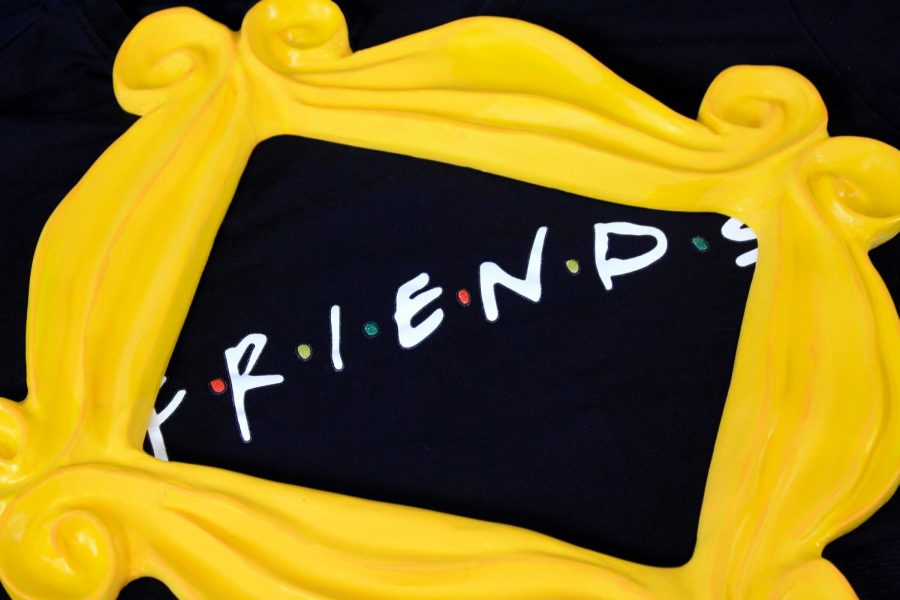Friends forever?
Popular TV show not-so-timeless
The TV show “Friends” debuted Sept. 22, 1994.
The familiar cityscape pulls up. A fountain with an orange couch in front hosts six 20-somethings, each dancing, laughing, singing, living a not-so-real young adult existence.
The television show “Friends” will turn 25 Sept. 22, 2019. The streaming platform Netflix will remove the show from its digital service in 2020. As hard-core fans soak up the last of their “Friends” fix, the rest of the world moves on.
This begs the question, am I, a devoted “Friends” fan, ready to move on? When I heard that one of my favorite TV shows was leaving the only streaming platform I subscribe to, I immediately pressed the play button on my smart phone and sat down in a dark room.
But, as I settled into the comfy routine of episode after episode, I realized something–the six main characters have nothing in common with me. Each one has characteristics I could identify with–the sarcastic Chandler, Monica who likes to cook, and Joey, who is a bit of an airhead, but really, the limited 10-year glimpse into each friend’s life ended the year I was born. As I reach the end of the tunnel in the “Friends” universe, I have come to the conclusion that “Friends” is totally outdated.
I’m not hating on “Friends”. The show is truly awesome in all of its fantastic ’90s nation pop culture references, clothing and city dwelling. But, the show has obviously been left behind. Sitcoms of yesteryear featured heavy laugh tracks, leading the actual views to chuckle along with them. Now though, groundbreaking comedies omit the constant false fits of cackles, opting for the more subtle, more realistic sarcastic comments, snide remarks and everyday conversations that lead into a laugh-out loud moments. There isn’t a push for viewers to laugh; it just happens naturally.
The other part of the show that I simply cannot stand is the lack of authenticity. While I am under the voting age and have no real life experience, I do understand the basic idea of money. The seasons show each group member struggling with jobs, relationships and finding their place in New York, but besides one episode early on, the show glosses over major struggles of many young adults. Sure, characters switch jobs, lose jobs, and gain jobs, but the series never strays from the predictable pattern of a character having no money one episode then magically being able to go on a shopping spree down Fifth Avenue three weeks later.
There are many things I could rant about this show, but I must admit, despite the flaws of this turn-of-the-century TV series, it’s still one of my favorites. I love how each friend knows everything about each other. I love how the friends stick together during the rockiest of times, and I love how every problem can be solved by a scone and a large cup of coffee. Despite my many, many grievances against “Friends”, I feel slightly jealous of the six.
A few sentences ago, I went on a tirade about the lack of accuracy in the series, but, there are parts that hold true to that era. Walking into a crowded coffee house now is like walking into a scene from “Fahrenheit 451.” Almost every person packed in there is staring down at a blue screen. On “Friends”, though, the members of the crew wince at the thought of leaving their conversation for a phone call. Whipping out their cell and flipping up it’s screen was something of a chore for any member of the group. They’re invested in the time they have with each other.
“Friends” has been a part of lives for 25 years now. While some aspects of the show have not aged well, the other parts of the series still hold true in a totally different time. As it departs Netflix, we bid farewell to a show that has played out in front of two generations.

Hi guys! I’m Caroline, and this is my fourth year in the journalism program and my third year writing for The Eagle's Tale. I am so excited to get back to working for the paper and writing about the wonderful people here at Canyon High as a senior....

Hey! I'm a senior and this will be my third and sadly final year on staff. I am currently one of the three editors-in-chief and the senior drum major for the band. I'm a true coffee addict who loves all the pups. In the rare situation I'm not on the band...











